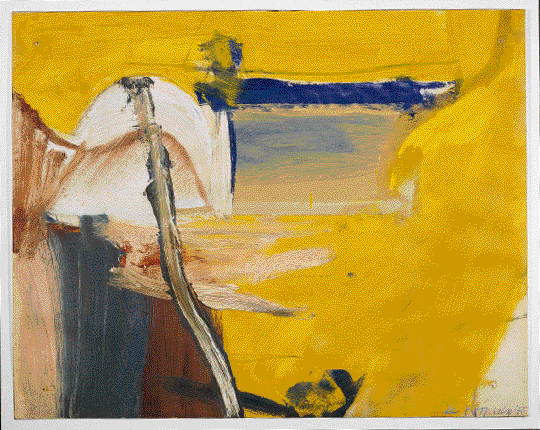
Willem de Kooning: Palisades, 1957
Oil on canvas, 6 feet 7 inches x 5 feet 9 inches (2 x 1.75 m).
Collection of Adriana and Robert Mnuchin
In the late 1930s and early 1940s, around the outbreak of World War II, many Surrealists fled Europe and settled in New York. Their interest in unmediated expression to reach the absolute soon influenced a young generation of painters struggling to find a voice for American art. The new movement, which became known as Abstract Expressionism, was heavily indebted to the ideas of the European pioneers of abstraction, including Vasily Kandinsky, whose work was championed in influenced a young generation of painters struggling to find a voice for American art. The new movement, which became known as Abstract Expressionism, was heavily indebted to the ideas of the European pioneers of abstraction, including Vasily Kandinsky, whose work was championed in this country by the Museum of Non-Objective Painting (subsequently renamed the Solomon R. Guggenheim Museum) beginning in 1939. Many of the Abstract Expressionists celebrated spontaneity and the exploration of the self in large paintings bursting with free form and gestural brushwork. The movement s free-wheeling spirit and its unbridled, heroic energy are exemplified both by Jackson Pollock's method of dripping paint directly onto the canvas in an improvisational act of art m aking and by Willem de Kooning's slashing of form and agitated brushstrokes. However, other artists associated with the movement avoided gesture and emphasized their paintings flatness. Barnett Newman, for example, explored the expression o f the sublime through large expanses of color interrupted by zips, one or more vertical lines of contrasting hue. Mark Rothko's brooding compositions, such as White Band (No. 27) (1954), represent a hybrid of gesture painting and the use of color fields. And the monochromatic paintings of Ad Reinhardt hark back to works by Kazimir Malevich and Piet Mondrian, in which pure color and geometric order provoke deep contemplation.
The Museum of Non-Objective PaintingAbstraction in the Twentieth Century
Abstraction in:
Photography